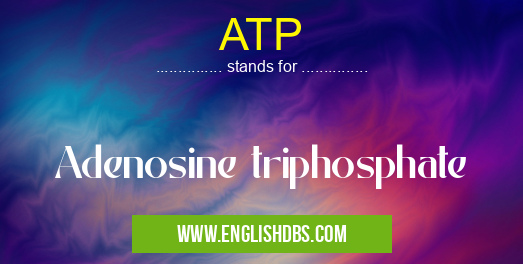What does ATP mean in CHEMISTRY
Adenosine triphosphate (ATP) is the primary energy currency of cells. It is a molecule consisting of three phosphate groups attached to a ribose sugar, which is in turn attached to the nitrogenous base adenine. ATP plays a crucial role in numerous cellular processes, including metabolism, muscular contraction, and nerve impulse transmission.

ATP meaning in Chemistry in Academic & Science
ATP mostly used in an acronym Chemistry in Category Academic & Science that means Adenosine triphosphate
Shorthand: ATP,
Full Form: Adenosine triphosphate
For more information of "Adenosine triphosphate", see the section below.
ATP Function
The energy stored in ATP is released when the terminal phosphate group is broken off through a process called hydrolysis. This hydrolysis reaction releases approximately 30.5 kJ/mol of energy, which can be used to drive various cellular reactions.
ATP functions as an intermediary in energy transfer processes. When energy is required for a cellular activity, ATP is broken down to ADP (adenosine diphosphate), releasing energy. Conversely, when energy is available from metabolic processes, ADP is converted back to ATP, storing the energy for later use.
ATP Synthesis
ATP synthesis primarily occurs through two main pathways:
- Cellular Respiration: During cellular respiration, ATP is produced in the mitochondria through oxidative phosphorylation.
- Photosynthesis: In plants and photosynthetic organisms, ATP is generated in the chloroplasts through the light-dependent reactions.
Clinical Significance
ATP levels and turnover rates can provide valuable insights into cellular health and disease states. Low ATP levels or impaired ATP turnover can indicate cellular stress, metabolic disorders, or neurodegenerative diseases. Therefore, monitoring ATP levels has clinical implications for evaluating cellular function and diagnosing certain conditions.
Essential Questions and Answers on Adenosine triphosphate in "SCIENCE»CHEMISTRY"
What is ATP?
Adenosine triphosphate (ATP) is a molecule that plays a crucial role in cellular energy metabolism. It consists of an adenine molecule, a ribose sugar, and three phosphate groups. ATP is the primary source of energy for cells, providing the energy required for various cellular processes, including muscle contraction, nerve impulse transmission, and chemical synthesis.
How does ATP store energy?
ATP stores energy in its phosphate bonds. The hydrolysis of these bonds, which involves the removal of a phosphate group, releases energy that can be utilized by cells. The energy stored in ATP is measured in kilocalories per mole (kcal/mol) or kilojoules per mole (kJ/mol).
How is ATP synthesized?
ATP is primarily synthesized through two main mechanisms: glycolysis and oxidative phosphorylation. Glycolysis occurs in the cytoplasm of cells and converts glucose into ATP, producing a small amount of ATP. Oxidative phosphorylation occurs in the mitochondria of cells and is much more efficient, producing a large amount of ATP.
What are the roles of ATP in cells?
ATP serves as the universal energy currency of cells, providing energy for a wide range of cellular processes. These processes include muscle contraction, nerve impulse transmission, chemical synthesis, active transport of molecules across cell membranes, and cell division.
What are the consequences of ATP depletion?
ATP depletion can have significant consequences for cells. When ATP levels are low, cells are unable to carry out essential processes, leading to impaired cellular function and potentially cell death. ATP depletion can occur due to various factors, such as hypoxia (lack of oxygen), mitochondrial dysfunction, or certain toxins.
Final Words: ATP is a fundamental molecule that plays a vital role in energy metabolism and cellular processes. Its ability to store and release energy on demand makes it the primary energy currency of cells. Understanding ATP's function and metabolism is essential for comprehending cellular physiology and various disease states.
ATP also stands for: |
|
| All stands for ATP |
